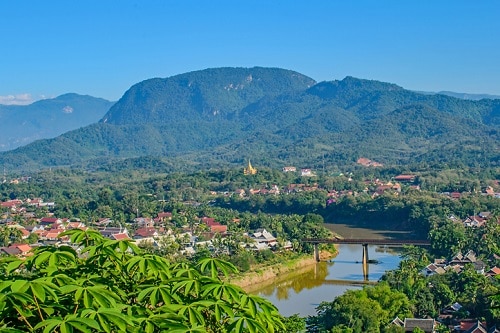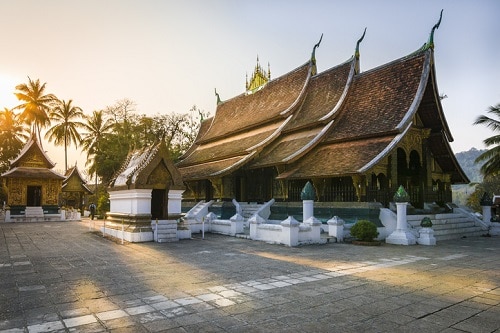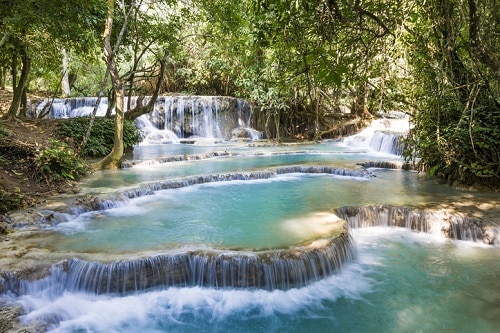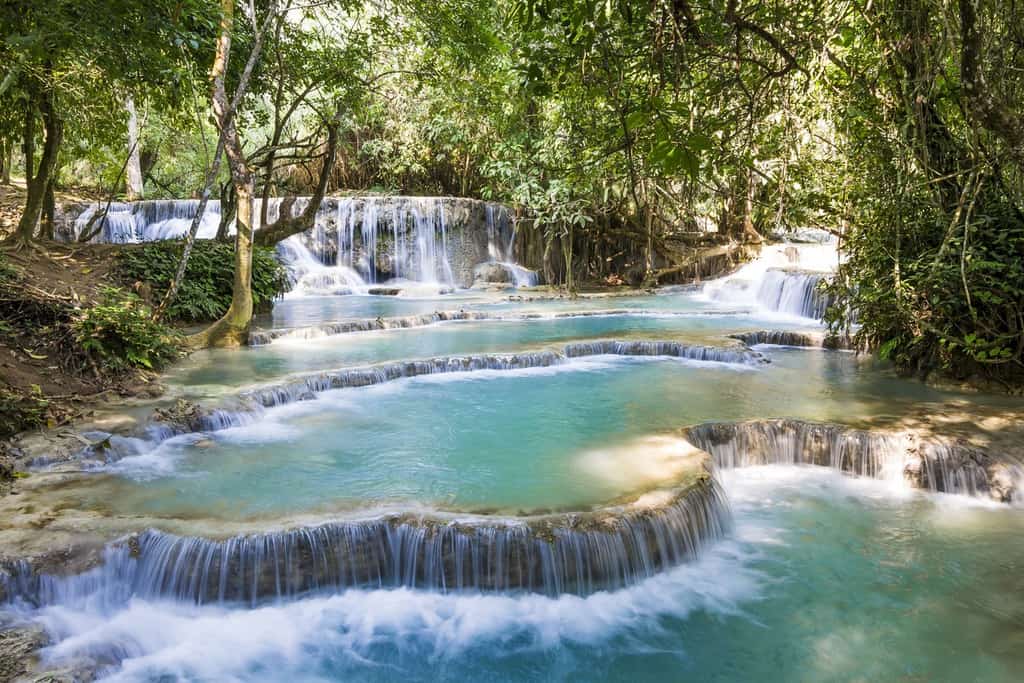There are many reasons to visit Luang Prabang, Laos’ second-largest city and former capital, which was designated a UNESCO Heritage Site in 1995. The charm of the city comes from the juxtaposition of French colonial architecture and Lao timber houses, in the form of quaint cafés and restaurants, and sprawling villas as hotels. It is also known for its spirituality and serenity, as after all, it is believed that Buddha smiled when he rested here for a day during his travels. He even prophesied that it would one day be the site of a rich and powerful city.
Today, the city is nestled between the Mekong and Nam Khan rivers, boasting of beautiful wats (temples), some dating back to the 16th century.
Travel Tips & Practicalities
How to get to Luang Prabang: It is best to fly from any major international airport to Bangkok or Hanoi, which offers multiple flights to Luang Prabang, with flying times of approximately 1 hour and 30 minutes (Bangkok) and 1 hour and 5 minutes (Hanoi).
Where to stay: The author stayed at Le Palais Juliana, which offers both villas and deluxe rooms in contemporary Lao style, close to the city center. However, there are many guesthouses and villas abound. International hotels Belmond La Résidence Phou Vao, Rosewood, Pullman and the ultraluxe Amantaka are also popular with visitors.
RELATED: Find Travel Tips & Tricks and Book Itineraries All Over the World with the Free Winetraveler App
Here are six things not to miss on an overnight trip to Luang Prabang:
Visit Pak Ou Caves for thousands of different-sized Buddhas
Framed by limestone cliffs, there are over 3,000 different-sized Buddha statues, in a variety of positions from meditation to teaching to nirvana (reclining), overlooking the Mekong River the cave is perched on. These statues are believed to have been left in the caves by locals for hundreds of years.
There are two main caves: the lower one (Tham Ting) is reachable from a staircase from the riverbank, and is often packed with throngs of tourists; the upper cave (Tham Theung) is a little quieter, with an entrance surrounded by trees.
It is a two-hour boat ride from the city, and some operators might include a visit to Ban Xang Hai, a local rice whisky distillation village, where they make lao-Lao, the country’s popular rice whisky—sometimes with scorpions or snakes suspended in the bottle.

Hike up Phousi Hill for some of the best views of Luang Prabang
Climbing 328 steps up the 100-meter hill is not without effort, but the reward is worth it: a 360-degree panoramic view of the city which makes for great photos, especially at sunset.
It is important to note that Mount Phousi is also sacred. The temple Wat Chom Si, built in 1804, sits atop of the mountain. While tourists flock to its terrace for the beautiful sunset views, monks and locals continue to lay offerings at the grotto.
Shop at the Night Market for souvenirs to take back home
On Sisavangvong Road, there are tons of gorgeous finds from colorful hand-woven pillowcases, elephant pants and bags, to intricately carved woodworks, to Laotian coffee, tea and rice wine—all of which are great deals with the art of bargaining (politely). They make thoughtful presents to bring back home.
The market is open from 5PM to 11PM daily. While the market is most vibrant at 8PM, arriving early will avoid the crowds.
Winetraveler Tip: The hike back down from Mount Phousi leads to the market, so it is advisable to plan on doing both together on the same day to hit two birds with one stone.
Wake up at dawn to participate in tak bat or alms-giving to the monks
Every day at 5:30 AM, Buddhist monks walk in silence around the city for their morning collection of food, while locals and tourists wait in the dark, kneeling on the sidewalk, armed with baskets of sticky rice, crackers and money. (Trivia: Before the Black Flag attacks of 1887, Luang Prabang had 67 temples from which monks emerged before daybreak to collect alms. Today, the monks come from the city’s remaining 30+ temples.)
Winetraveler Tip: It is important to avoid taking pictures up close, as a sign of respect, and also to dress appropriately in that shoulders, legs, and chest need to be covered.

Observe Buddha’s hands at popular temples Wat Xieng Thong and Wat Wisunarat
Wat Xieng Thong is the most famous and grandest temple in Luang Prabang. Built in the 16th century, gold wooden doors recount the life of Buddha, and it is often highlighted for its elegantly ornamented roof featuring a bird displaying its colorful wings.
Wat Wisunarat is Luang Prabang’s oldest temple, built in the 15th century which served as a home for Prabang’s Buddha’s before being destroyed during the Chinese invasion in 1887. It is sometimes referred to as the “Watermelon Temple,” because of its uniquely shaped stupa.
Notice Buddha’s hands. When he has both arms down at his sides, palms against thighs, it reveals that he is calling for the rain. On the other hand, two hands with palms facing outward mean that he is telling the Lao people to stop fighting over water for their farms.
As with all temples, it is important to dress appropriately, and to remember that shoes must be taken off upon entry.

Swim at—or hike up—the multi-tiered Kuang Si Falls
Located 30 kilometers from Luang Prabang, the multi-tiered Kuang Si Falls is a popular side trip for tourists. It drops 50 meters and cascades into turquoise terraces, pillows of
water and mist. There are a few pools where visitors can swim in the area, but it is important to take note that some are off-limits as they are considered sacred by the locals. Next to the left of the wooden footbridge are steps leading up to the top, with some of the best views of the Lao countryside.
Winetraveler Tip: While it takes only 15 minutes or so, it can be a little slippery—as some parts are without railings—so packing non-slip shoes are advisable (flipflops are not) and a light waterproof jacket as it can be quite misty in the area.
